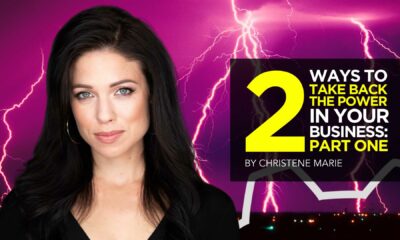SOCIAL
There Will be Ways to Generate More Revenue from Twitter, But $8 Verification Isn’t It

Will you be paying $8 per month to get a blue verification badge?
Elon Musk’s push to rapidly monetize Twitter, and get the business on track, in order to recoup his massive costs and investor commitments, has already led to some interesting proposals, none of which has been set in stone as yet. But Musk has clearly set his sights on charging users $8 per month for the prestigious verified marker, in order to solve what Elon sees as a class issue within the app.
Twitter’s current lords & peasants system for who has or doesn’t have a blue checkmark is bullshit.
Power to the people! Blue for $8/month.
— Elon Musk (@elonmusk) November 1, 2022
But that’s not really the issue, or an issue at all, because for one, the blue checkmark isn’t always allocated to celebrities, because Twitter has altered the qualifying parameters for verification at various times. That means that you’ll often come across randoms with a tick, so it’s not really a definitive stamp of importance anyway.
But also, if the concept is that the blue checkmark is a signifier of importance – of ‘lords’ of Twitter, as Musk says – that’ll be completely eliminated by making it available to everyone, either way, because once anyone can get one, it means nothing anymore, right? If the true value of the checkmark, under this interpretation, is to signify perceived importance, then as soon as anybody can buy one, that value immediately evaporates.
Right?
This is most confusing aspect of Musk’s pitch – Elon seems to have assessed that this is something that people want, based on the amount of users asking for verification, which then makes it valuable, and something that Twitter can sell for a quick buck.
But by selling to anyone, that then devalues it completely, and I’m not sure how that’s going to make it an ongoing value proposition.
To be fair, Musk has also outlined other value-add elements in paying up, including:
- Priority in replies, mentions and search
- Ability to post long video and audio
- Half as many ads
- Paywall bypass for selected publishers
So it’s not just the blue tick of approval, there could also be particular value in getting your replies seen more prominently in the app.
But then again, the more people that sign up, the less that ‘priority’ means. For example, if you were signing up in order to, say, ensure that your messages get seen when you reply to a viral tweet, by having them listed higher in the reply chain, if thousands of other people who’ve also signed up for verification have that same idea, that’ll only see your tweet listed among the many, many others vying for attention.
Another factor to consider here is that the majority of users actually don’t tweet, so this would be of no value to them anyway.
According to research, 25% of Twitter users produce around 97% of all tweets.
So priority display of tweets is probably not a major selling point for most people either way.
And then there’s the confusion caused by re-aligning what the verification tick actually means.
For example, what happens to celebrities that don’t sign up to pay $8 per month, and lose their blue checkmark as a result? Elon has noted that there will be an additional marker for public figures, in addition to the blue tick. But will that be enough?
To clarify, the original concept of the verification tick on Twitter came about due to a case of celebrity impersonation, which saw an MLB player take Twitter to court after somebody registered his name in the app and began posting offensive comments. In the wash-up from this incident (and various other cases of impersonation of celebrities), Twitter then launched its verification program to tackle the problem – so Twitter created the verified tick to indicate that this was the real, actual person that you’re thinking of, not, it’s important to note, as a marker of status.
But let’s say that The Rock now declines to pay the $8, for the sake of argument. Now, any scammer can create an account pretending to be The Rock, then pay to get the blue tick, which they could then use to dupe people into thinking this is the real Dwayne Johnson that’s looking to pitch them on some new crypto investment.
And really, even if The Rock did pay, they could still do this. With no official marker of actual authentication in the app, there’ll be fewer ways for people to verify that this is or isn’t a legitimate profile – and while most western users might be relatively savvy to scams like this, people in developing markets could be particularly susceptible to such scams.
Related: Elon’s also looking to beam Twitter into more regions where it’s currently not available via Starlink internet access.
Scammers will already be planning their attacks on this front, using the confusion around what the blue tick means to take what they can. Which, again, will further devalue the blue tick, and I’m guessing that, within a few months, few people will see much point in continuing to pay for the marker, as it will have lost all perceived value due to this type of misuse.
Yet at the same time, I do think that there could be value in charging for tweet subscriptions. But class warfare is not it.
According to a study conducted by Twingate in 2020, many social media users would indeed consider paying a certain amount to use social media apps, if there were a significant value add in doing so – like, say, removing all ads or eliminating data tracking (for ads).
Twingate’s research shows that some users would be willing to pay around $4 to use Twitter without ads or tracking, and that seems like it could be a better pitch for this than Elon’s current strategy.
Though that may not match up with Elon’s other plan, in eliminating bots through verification.
Based on what Musk has outlined, he seems to be of the impression that he’ll eventually be able to get most Twitter users to pay for verification, and if that happens, that will effectively eliminate Twitter’s problems with bot armies, because the providers and programs behind such will then have to pay $8 per account to continue their efforts.
Because the only people not verified will be bots, which will make them really easy to spot – and as such, the price has to be $8, or as much as people will viably spend, in order to act as a significant enough disincentive for bot operators.
But while Musk seems to think that $8 is nothing – which it is when you’re worth $223 billion – it’s actually probably quite a lot for most Twitter users, especially considering the average income data for the app’s user base.

As you can see in this listing from Pew Research, 63% of Twitter users earn less than $75k per annum, and to those people, I’m guessing $96 a year is a significant amount, especially for something that they don’t need in order to keep using the app, and which further declines in value with every person that signs up.
And this data is only for the US – the vast majority of Twitter’s audience (almost 80%) are from regions outside the US, with many in developing markets, where $96 is a huge amount.
Elon has also noted that there will be variable pricing by region. But even then, will people really want to pay for something that adds not a lot to their in-app experience?
In the end, I don’t see this being a major winner for the app, but there may be another way to pitch subscriptions that does offer value to the Twitter experience.
But this isn’t it, and really, it feels exactly like what it is – a rushed project that hasn’t been thought through, which might see a sudden surge early on, but will fall apart very quickly, and cause more problems than it’s worth.
And that’ll only be exacerbated by job cuts at the app.
Make no mistake, Twitter is able to generate more revenue, and there are ways that it could be reformed and re-shaped in Elon’s vision.
But we could be in for a fair bit of trial and error before we get to anything concrete.
SOCIAL
Snapchat Explores New Messaging Retention Feature: A Game-Changer or Risky Move?

In a recent announcement, Snapchat revealed a groundbreaking update that challenges its traditional design ethos. The platform is experimenting with an option that allows users to defy the 24-hour auto-delete rule, a feature synonymous with Snapchat’s ephemeral messaging model.
The proposed change aims to introduce a “Never delete” option in messaging retention settings, aligning Snapchat more closely with conventional messaging apps. While this move may blur Snapchat’s distinctive selling point, Snap appears convinced of its necessity.
According to Snap, the decision stems from user feedback and a commitment to innovation based on user needs. The company aims to provide greater flexibility and control over conversations, catering to the preferences of its community.
Currently undergoing trials in select markets, the new feature empowers users to adjust retention settings on a conversation-by-conversation basis. Flexibility remains paramount, with participants able to modify settings within chats and receive in-chat notifications to ensure transparency.
Snapchat underscores that the default auto-delete feature will persist, reinforcing its design philosophy centered on ephemerality. However, with the app gaining traction as a primary messaging platform, the option offers users a means to preserve longer chat histories.
The update marks a pivotal moment for Snapchat, renowned for its disappearing message premise, especially popular among younger demographics. Retaining this focus has been pivotal to Snapchat’s identity, but the shift suggests a broader strategy aimed at diversifying its user base.
This strategy may appeal particularly to older demographics, potentially extending Snapchat’s relevance as users age. By emulating features of conventional messaging platforms, Snapchat seeks to enhance its appeal and broaden its reach.
Yet, the introduction of message retention poses questions about Snapchat’s uniqueness. While addressing user demands, the risk of diluting Snapchat’s distinctiveness looms large.
As Snapchat ventures into uncharted territory, the outcome of this experiment remains uncertain. Will message retention propel Snapchat to new heights, or will it compromise the platform’s uniqueness?
Only time will tell.
SOCIAL
Catering to specific audience boosts your business, says accountant turned coach

While it is tempting to try to appeal to a broad audience, the founder of alcohol-free coaching service Just the Tonic, Sandra Parker, believes the best thing you can do for your business is focus on your niche. Here’s how she did just that.
When running a business, reaching out to as many clients as possible can be tempting. But it also risks making your marketing “too generic,” warns Sandra Parker, the founder of Just The Tonic Coaching.
“From the very start of my business, I knew exactly who I could help and who I couldn’t,” Parker told My Biggest Lessons.
Parker struggled with alcohol dependence as a young professional. Today, her business targets high-achieving individuals who face challenges similar to those she had early in her career.
“I understand their frustrations, I understand their fears, and I understand their coping mechanisms and the stories they’re telling themselves,” Parker said. “Because of that, I’m able to market very effectively, to speak in a language that they understand, and am able to reach them.”Â
“I believe that it’s really important that you know exactly who your customer or your client is, and you target them, and you resist the temptation to make your marketing too generic to try and reach everyone,” she explained.
“If you speak specifically to your target clients, you will reach them, and I believe that’s the way that you’re going to be more successful.
Watch the video for more of Sandra Parker’s biggest lessons.
SOCIAL
Instagram Tests Live-Stream Games to Enhance Engagement

Instagram’s testing out some new options to help spice up your live-streams in the app, with some live broadcasters now able to select a game that they can play with viewers in-stream.
As you can see in these example screens, posted by Ahmed Ghanem, some creators now have the option to play either “This or That”, a question and answer prompt that you can share with your viewers, or “Trivia”, to generate more engagement within your IG live-streams.
That could be a simple way to spark more conversation and interaction, which could then lead into further engagement opportunities from your live audience.
Meta’s been exploring more ways to make live-streaming a bigger consideration for IG creators, with a view to live-streams potentially catching on with more users.
That includes the gradual expansion of its “Stars” live-stream donation program, giving more creators in more regions a means to accept donations from live-stream viewers, while back in December, Instagram also added some new options to make it easier to go live using third-party tools via desktop PCs.
Live streaming has been a major shift in China, where shopping live-streams, in particular, have led to massive opportunities for streaming platforms. They haven’t caught on in the same way in Western regions, but as TikTok and YouTube look to push live-stream adoption, there is still a chance that they will become a much bigger element in future.
Which is why IG is also trying to stay in touch, and add more ways for its creators to engage via streams. Live-stream games is another element within this, which could make this a better community-building, and potentially sales-driving option.
We’ve asked Instagram for more information on this test, and we’ll update this post if/when we hear back.
-

 SEO7 days ago
SEO7 days agoGoogle Limits News Links In California Over Proposed ‘Link Tax’ Law
-

 SEARCHENGINES6 days ago
SEARCHENGINES6 days agoGoogle Core Update Volatility, Helpful Content Update Gone, Dangerous Google Search Results & Google Ads Confusion
-
SEARCHENGINES7 days ago
Daily Search Forum Recap: April 12, 2024
-

 SEO6 days ago
SEO6 days ago10 Paid Search & PPC Planning Best Practices
-

 MARKETING6 days ago
MARKETING6 days ago2 Ways to Take Back the Power in Your Business: Part 2
-

 MARKETING5 days ago
MARKETING5 days ago5 Psychological Tactics to Write Better Emails
-

 SEARCHENGINES5 days ago
SEARCHENGINES5 days agoWeekend Google Core Ranking Volatility
-

 PPC7 days ago
PPC7 days agoCritical Display Error in Brand Safety Metrics On Twitter/X Corrected













You must be logged in to post a comment Login